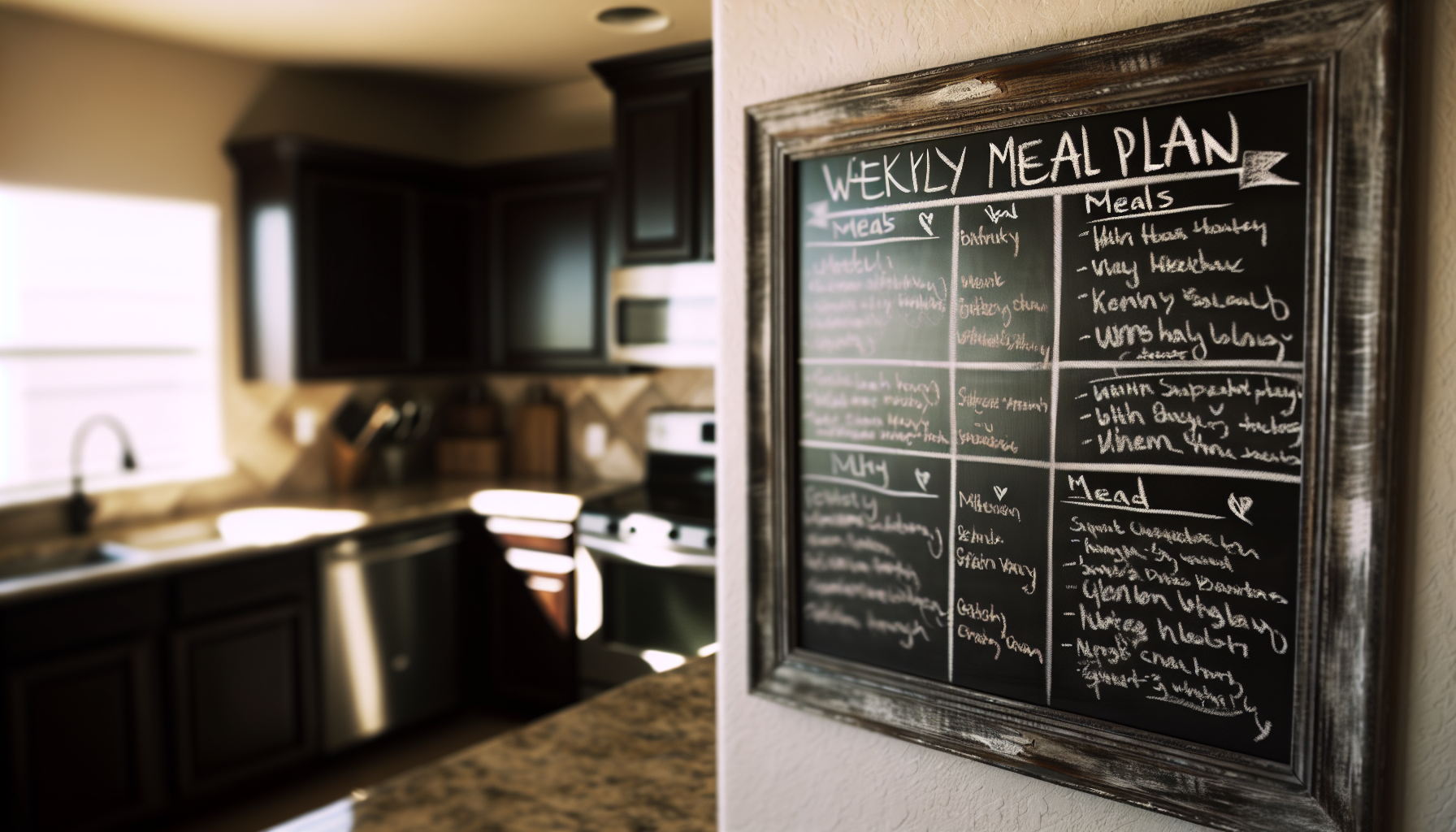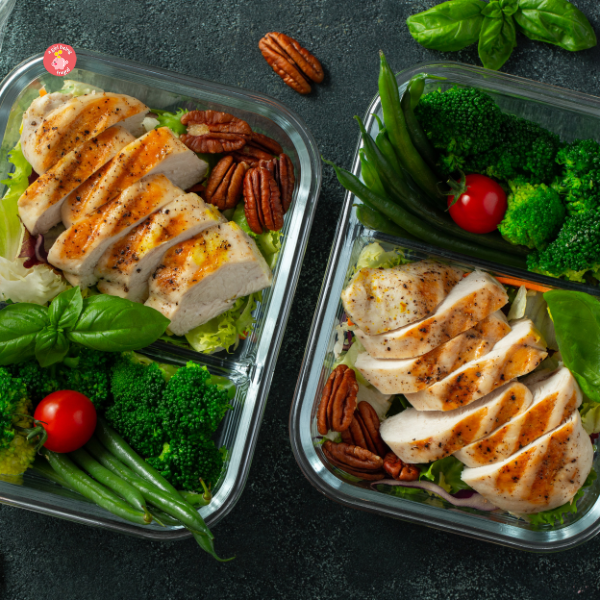What should you buy on a grocery run for two? If you’re aiming for a balance of nutrition and affordability, this focused guide provides a straightforward grocery list for 2 adults. Covering the essentials from proteins to produce and pantry items, we help you fill your cart wisely. Plan your meals for the week, save money, and maintain a healthy lifestyle with our easy-to-follow list.
Key Takeaways
- A well-planned grocery list with affordable proteins, various fruits and vegetables, and essential pantry staples helps maintain a healthy lifestyle while staying on budget.
- Meal planning for two, considering leftovers, and having themed dinner days streamline mealtimes, reduce waste, and can save time and money.
- Smart shopping techniques like buying seasonal items on sale, bulk purchasing with caution, and efficient food storage help maximize savings without sacrificing food quality.
Crafting Your Two-Person Grocery List
A well-planned grocery list can significantly benefit budget-conscious and health-minded couples, as it helps them manage their week grocery budget effectively. It’s all about cleverly selecting your proteins, fruits, vegetables, and pantry staples.
Wondering how to fill your cart while staying budget-friendly? Let’s find out!
Essential Proteins: Chicken, Eggs, and More
Proteins, serving as our bodies’ building blocks, are vital to maintaining our health and well-being. But who said proteins have to be pricey? You can find plenty of affordable options packed with the essential amino acids your body needs.
Poultry, like chicken breasts, is a staple protein source for many households. Eggs, too, offer a versatile and cheap protein option. You can easily incorporate them into your breakfast, lunch, or dinner recipes. Are you aware that a healthy individual can comfortably consume up to seven eggs weekly? So, remember to add these protein champs to your shopping list.
Vegetables and Fruits: Fresh, Frozen, and Canned
The saying ‘an apple a day keeps the doctor away’ holds true, but why stop there? Let’s add a variety of fruits and veggies to our daily meals. Strive to have at least five servings of fruits and vegetables per day to maintain a healthy lifestyle. Now, picking the right fruits and veggies for your grocery list can seem overwhelming, but it doesn’t have to be!
Regardless of whether you opt for fresh, frozen, or canned fruits and veggies, the focus should always be on nutrient-dense choices. Fresh veggies like spinach, carrots, broccoli, and kale are always great choices. But don’t underestimate the power of frozen veggies. They’re often packed with nutrients, convenient, and cost-effective, making them a smart choice for budget-conscious shoppers like us.
As for canned goods, they can be just as nutritious as fresh or frozen ones, and sometimes even more so. So, no matter what form they come in, fruits and veggies are a must-add to your grocery list.
Pantry Staples: Grains, Spices, and Oils
A well-stocked pantry sets the stage for a culinary adventure. You need a variety of grains, spices, and oils to make sure you can whip up any meal you fancy.
Grains like millet, buckwheat, oats, and quinoa are a must-have in your pantry. They’re not only nutritious but also quite versatile, fitting perfectly into a variety of dishes.
Spices, meanwhile, are your ticket to a world of flavors. Essentials like cinnamon, nutmeg, cloves, and bay leaves, along with fresh herbs, can easily transform your meals from bland to grand.
And let’s not forget about oils. Whether it’s extra-virgin olive oil, coconut oil or light olive oil, each has its unique health benefits and cooking uses. Just remember to store these pantry staples properly to maintain their freshness and maximize their shelf life.
Mastering Meal Planning for Two
Mastering the art of meal planning can turn your stressful mealtimes into relaxing experiences. It not only ensures you have a variety of dishes to enjoy throughout the week, but it also helps you save time, reduce food waste, and stay within your budget.
Let’s embark on the journey of meal planning and discover how to excel at it!
Mapping Out the Week

Effective meal planning hinges on organization and strategic thinking. You’ll be surprised at how much time and money you can save by planning your meals for the week ahead.
There are many ways to plan your meals. Here are some ideas to consider:
- Have a strict schedule
- Have a flexible schedule
- Have themed days (e.g. Meatless Monday, Taco Tuesday)
- Consider everyone’s dietary needs and preferences
- Balance your nutrients
- Keep an eye on your budget
- Get creative with your meal prep (e.g. smoky chicken and cinnamon roasted sweet potato meal prep, roasted vegetable couscous meal prep)
It’s all about finding what works best for you!
The Art of Leftovers
Often overlooked, leftovers play a significant role in meal planning. They not only save you time and effort but can also bring variety to your meals.
Ever thought of whipping up some tacos, burritos, or soups from last night’s dinner? Or perhaps transforming that leftover chicken into a delicious enchilada?. The possibilities are endless! And don’t worry about your leftovers losing their taste. If stored properly, they can stay fresh and delicious for three to four days. So, let’s embrace the art of leftovers and make the most of every meal!
Budget-Friendly Recipes for Two
With our pantry filled and meal plan set, we’re ready to don our chef hats and embark on our cooking adventure! Here is a collection of budget-friendly recipes that are not only delicious but also nutritious.
Let’s get started!
Quick and Nutritious Breakfasts
Breakfast is the most important meal of the day, and it doesn’t have to be a drag. Let’s kickstart our day with these quick and nutritious breakfast recipes.
How about a Cinnamon-Quinoa Breakfast Bowl or 3-Ingredient Baked Feta & Cherry Tomato Egg Muffins? Or perhaps a Peanut Butter-Banana English Muffin to satisfy your sweet tooth? Remember, the key is to include a balance of proteins, carbs, and fats in your meal. With these recipes, you can start your day on a healthy note without spending too much time or money.
Light and Easy Lunches
Lunchtime should be a break from your hectic day, not a cause of stress. That’s why we’ve gathered some light and easy lunch recipes you can whip up in no time.
Some lunch recipes that are easy to prepare and light on your wallet include:
- BLT Skillet
- Ground Beef Taco Salad
- Quick Ginger Pork
- Classic Egg Salad
- Peanut Butter Sandwiches
These recipes promise to satisfy your hunger without weighing you down. So, whether you’re home or at work, these lunch recipes have you covered.
Delicious Dinners: From Slow Cooker to Stir Fry
Dinner is the time to unwind and enjoy a hearty meal. And who said hearty has to be heavy or expensive? We’ve got some delicious dinner recipes that are easy on your budget and your waistline.
Whether you’re in the mood for a slow cooker meal or a quick stir fry, we’ve got you covered. Here are some delicious recipes to try:
- Chicken Parmesan and Pasta Casserole
- Slow Cooker Chicken and Gravy
- Lazy Lasagna
- Loaded Chicken Baked Potatoes
These tight budget recipes are sure to please your palate without straining your budget.
Maximizing Savings at the Grocery Store
Everyone appreciates a good bargain, especially for groceries. Let’s uncover strategies to maximize our grocery savings without sacrificing food quality.
Shopping Sales and Seasonal Offers
Sales and seasonal offers can be a goldmine for budget-conscious shoppers. Knowing when and what to buy can save you a significant amount of money on your grocery bill.
Did you know that Wednesday mornings are the best time to snag sales at grocery stores? That’s when they usually roll out new deals. Also, keeping an eye on seasonal offers can save you a lot of money. Foods that are in season are usually cheaper and fresher, so they’re more nutritious.
There are also various tools available to help you keep track of sales and discounts. By taking advantage of these opportunities, you can enjoy a variety of healthy foods without stretching your budget.
Bulk Buying Wisdom
When done wisely, purchasing in bulk, especially staple items such as cleaning supplies, coffee, pet food, and personal care products, can yield significant savings.
Buying in bulk can save you money through lower prices per item and reduced packaging waste. But keep in mind that bulk buying involves a higher upfront cost and requires adequate storage space. Also, be mindful of the shelf life of the items you buy in bulk to avoid food waste.
With careful planning and smart shopping, bulk buying can be a powerful tool for saving money and keeping your grocery bill within your budget.
Storing and Preserving Your Groceries
Efficient storage and preservation of groceries can contribute to waste reduction and monetary savings.
Let’s unlock the secrets to extending the freshness of our groceries, including sour cream.
Freezer Management
A well-managed freezer can be an invaluable tool in preserving food and maintaining its quality. Let’s delve into effective freezer management techniques.
The ideal freezer temperature to keep your groceries fresh is 0 degrees Fahrenheit (or -18 degrees Celsius). Also, be aware that not everything can be frozen. Items like:
- lettuce
- mayonnaise
- cream cheese
- cooked pasta or rice
Can lose their texture and quality when frozen. Generally, most foods can last in the freezer from one to 12 months, with raw chicken lasting up to 12 months and cooked poultry for 4 to 6 months.
Proper freezer management, including the use of freezer meals, can significantly extend the shelf life of your groceries and help you save money.
Keeping Your Pantry Organized
Keeping your pantry well-organized can streamline meal preparation and facilitate ingredient tracking. Let’s explore how to keep our pantry in top shape.
The first step to an organized pantry is to take stock of what you have and categorize your items. Using see-through containers and labels can help you easily find and access your ingredients. Also, make use of all the available space in your pantry to store as much as possible.
With an organized pantry, you’ll not only save time during meal prep but also prevent food waste by using all your ingredients before they go bad.
Eating Healthy Without Breaking the Bank
Healthy eating doesn’t have to be a costly affair. Utilizing a few intelligent strategies can allow you to eat healthy and savor nutritious meals without depleting your wallet.
Let’s learn how to achieve this!
Balancing Cost and Nutrition
Striking a balance between cost and nutrition is crucial for maintaining a healthy diet on a budget. But how do we achieve this balance? Here are some tips:
- Incorporate cheaper protein sources like beans, legumes, and eggs to significantly reduce your grocery bill without compromising your health.
- Include a variety of foods from different groups and mix up colors, shapes, flavors, and textures in your meals to ensure a balanced diet.
- Don’t forget about the power of homemade alternatives. They can be healthier and more budget-friendly than their store-bought counterparts.
With these strategies, you can enjoy budget friendly meals without stretching your budget.
Smart Substitutions
Intelligent ingredient substitutions can significantly impact the cost-effectiveness and nutritional value of your meals. Let’s look at some alternatives that can save you money while keeping your meals healthy and delicious.
Substituting meat with plant-based proteins like beans, legumes, or tofu can not only save you money but also add a variety of nutrients to your diet. Also, there are many affordable dairy-free milk options like oat milk, hemp milk, and almond milk that you can consider. And for your grains, opting for brown rice, oats, and barley can provide good nutrition without costing a fortune. These smart substitutions can help you maintain a healthy and budget-friendly diet.
Summary
We’ve covered a lot of ground in this journey towards budget-friendly, healthy meal planning for two. From creating a well-planned grocery list and mastering meal planning to managing your freezer and pantry, we’ve learned how to make the most out of our groceries. Remember, eating healthy doesn’t have to be expensive. With smart planning, strategic shopping, and creative cooking, you can enjoy nutritious meals without breaking the bank. So, let’s put these tips into practice and embark on this journey towards a healthier, happier life!
Frequently Asked Questions
What is a realistic grocery budget for 2 people?
A realistic grocery budget for 2 people is around $254 per person annually, which amounts to about $5,635 per year for the household.
How to eat on $100 dollars a month?
Plan your meals around low-cost staple foods like oats, eggs, tuna, peanut butter, cheese, nonfat yogurt, and inexpensive cuts of meat like chicken thighs or flank steak, along with dried beans and grains. This will help you eat on a budget and manage your expenses.
How to only spend $200 a month on groceries?
To spend only $200 a month on groceries, set a budget, shop at cheaper stores, buy in bulk, opt for store brands, plan meals around savings, use loyalty rewards programs, and consider plant-based proteins. Additionally, use a cash-back app to save more. Keep track of these strategies and start implementing them to see your grocery spending decrease significantly.
What is 5 4 3 2 1 grocery shopping?
The 5 4 3 2 1 grocery shopping method involves buying six vegetables, five fruits, four proteins, three starches, two sauces or spreads, and one fun item for yourself. It’s designed to help you maintain a balanced and healthy diet.
What food should I buy for 2 weeks?
Buy meats, vegetables, and fruits with a long shelf life, such as chicken breasts, carrots, potatoes, apples, and frozen vegetables, to ensure they last for two weeks.





